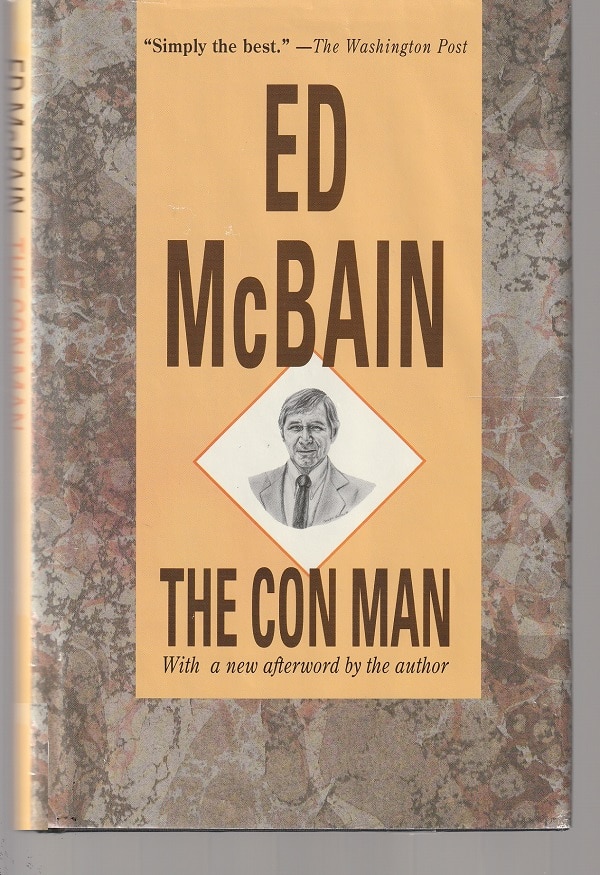Teddy Carella is the hero of Ed McBain’s fourth 87th Precinct novel The Con Man, published in 1957.
Teddy — Theodora — was born without the ability to speak and without the ability to hear. But she’s quite a woman — smart and sensitive, clever and alert.
She tracks a killer and his already poisoned next victim through the streets of McBain’s City (which feels very much like New York) and finds ways to get a message to her detective husband Steve and his colleagues.
As McBain writes in the afterward of the Armchair Detective Library edition of The Con Man, Teddy is
a woman who could not by the farthest stretch of the imagination be considered “handicapped.”
“The simple act”
In the previous book The Pusher, Steve had been shot and close to death. So, as McBain explains in the afterward, he wanted to give Teddy her own star turn.
She rises above the run-of-the-mill wife in the series and, for that matter, above the run-of-the-mill detective not only by solving the crime but, even more, by getting a small butterfly tattooed to her right shoulder. McBain writes:
I never thought of Teddy as being handicapped, anyway, but it seemed to me that with the simple act of acquiring a tattoo, she achieved the heroic dimensions essential to tracking a killer, thereby elevating her to proper STARDOM alongside her big-hero husband.
That relates to one other aspect of Teddy that sets her apart from the run of the mill — she’s gorgeous. So, when she decides to get the tattoo, the reader knows that, given her beauty and style, it can’t help but be just right.
“Pretty detective lady”
The scene in which Teddy gets her tattoo — remember: this is more than sixty years ago when very few women got tattoos — is a joyful meeting of a club of two people who like each other as soon as they meet.

Steve brought Teddy to the tattoo shop of Charlie Chen while running a work errand before they went to dinner. Now, Teddy has returned on her own, and Chen is full of happiness to see her again.
“Oh!” he said, and then his round face broke into a delighted grin. “Pretty detective lady come back,” he said. “Charlie Chen is much honored. Charlie Chen is much flattered. Come, sit down, Mrs….” He paused. “Charlie Chen forget name.”
It’s at this point that Teddy explains through signs that she can neither speak nor hear. But Chen realizes that she is able to read his lips. And, although he speaks broken English, she’s able to understand him, and he learns that she’s come back for the butterfly tattoo he’s suggested on her first visit.
“Good things”
Teddy indicates she wants a butterfly that is not too big and not too small on her shoulder.
“Ah, very clever, very clever. Delicate butterfly for pretty lady. Big butterfly no good. Small, little, pretty butterfly better. You very smart. Come. Come in. Please. Come in.”
And so it goes between them, their communication and affection rising above the mundane details of their limitations. Even to the point that Chen opens his heart to her, telling Teddy about marrying the “prettiest lady in Shanghai…She make me very happy…Everything clear and bright.” But then:
His eyes had glazed somewhat, and Teddy watched him, feeling a sadness in the man even before his next words.
“She die,” he said. “Life very funny. Good things die early, bad ones never die. She die, life is grey again.”
The mystery at the heart of The Con Man is solved by Teddy with only a slight — well, important — help from Steve.
But it’s Teddy’s visit with Charlie Chen that the reader will remember. And savor.
Patrick T. Reardon
7.28.21
Written by : Patrick T. Reardon
For more than three decades Patrick T. Reardon was an urban affairs writer, a feature writer, a columnist, and an editor for the Chicago Tribune. In 2000 he was one of a team of 50 staff members who won a Pulitzer Prize for explanatory reporting. Now a freelance writer and poet, he has contributed chapters to several books and is the author of Faith Stripped to Its Essence. His website is https://patricktreardon.com/.
